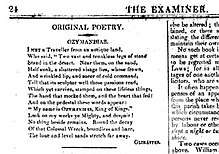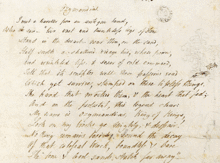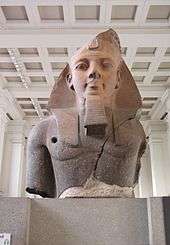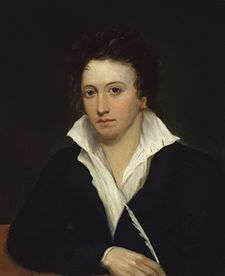Ozymandias
| by Percy Bysshe Shelley | |
 Shelley's "Ozymandias" in The Examiner | |
| First published in | 11 January 1818 |
|---|---|
| Country | England |
| Language | Modern English |
| Form | Sonnet |
| Meter | Loose iambic pentameter |
| Rhyme scheme | ABABA CDCEDEFEF |
| Publisher | The Examiner |
| Read online | Ozymandias (Shelley) at Wikisource |
| by Horace Smith | |
| First published in | 1 February 1818 |
|---|---|
| Country | England |
| Form | Sonnet |
| Publisher | The Examiner |
| Read online | Ozymandias (Smith) at Wikisource |

"Ozymandias" (/ˌɒziˈmændiəs/ oz-ee-MAN-dee-əs)[1] is the title of two poems published in 1818.
English Romantic poet Percy Bysshe Shelley (1792–1822) wrote a sonnet, first published in the 11 January 1818 issue of The Examiner[2] in London. It was included the following year in Shelley's collection Rosalind and Helen, A Modern Eclogue; with Other Poems (1819)[3] and in a posthumous compilation of his poems published in 1826.[4] "Ozymandias" is Shelley's most famous work and is frequently anthologised.
Shelley wrote the poem in friendly competition with his friend and fellow poet Horace Smith (1779–1849), who also wrote a sonnet on the same topic with the same title. Smith's poem was published in The Examiner a few weeks after Shelley's sonnet. Both poems explore the fate of history and the ravages of time: even the greatest men and the empires they forge are impermanent, their legacies fated to decay into oblivion.
In antiquity, Ozymandias (Ὀσυμανδύας) was a Greek name for the Egyptian pharaoh Ramesses II. Shelley began writing his poem in 1817, soon after the announcement of the British Museum's acquisition of a large fragment of a statue of Ramesses II from the thirteenth century BC, leading some scholars to believe that Shelley was inspired by this. The 7.25-ton fragment of the statue's head and torso had been removed in 1816 from the mortuary temple of Ramesses at Thebes by Italian adventurer Giovanni Battista Belzoni. It was expected to arrive in London in 1818, but did not arrive until 1821.[5][6]
Writing and publication history

Publication history
The banker and political writer Horace Smith spent the Christmas season of 1817–1818 with Percy Bysshe Shelley and Mary Shelley. At this time, members of Shelley's literary circle would sometimes challenge each other to write competing sonnets on a common subject: Shelley, John Keats and Leigh Hunt wrote competing sonnets on the Nile around the same time. Shelley and Smith both chose a passage from the writings of the Greek historian Diodorus Siculus, which described a massive Egyptian statue and quoted its inscription: "King of Kings Ozymandias am I. If any want to know how great I am and where I lie, let him outdo me in my work." In the poem Diodorus becomes "a traveller from an antique land."[7]
The two poems were later published in Leigh Hunt's The Examiner,[2] published by Leigh's brother John Hunt in London. (Hunt was already planning to publish a long excerpt from Shelley's new epic, The Revolt of Islam, later the same month.)
Shelley's poem
Shelley's poem was published on 11 January 1818 under the pen name Glirastes. It appeared on page 24 in the yearly collection, under Original Poetry. Shelley's poem was later republished under the title "Sonnet. Ozymandias" in his 1819 collection Rosalind and Helen, A Modern Eclogue; with Other Poems by Charles and James Ollier[3] and in the 1826 Miscellaneous and Posthumous Poems of Percy Bysshe Shelley by William Benbow, both in London.[4]
Smith's poem
Smith's poem was published, along with a note signed with the initials H.S., on 1 February 1818.[8] It takes the same subject, tells the same story, and makes a similar moral point, but one related more directly to modernity, ending by imagining a hunter of the future looking in wonder on the ruins of a forgotten London. It was originally published under the same title as Shelley's verse; but in later collections Smith retitled it "On A Stupendous Leg of Granite, Discovered Standing by Itself in the Deserts of Egypt, with the Inscription Inserted Below".[9]
Comparison of the two poems
|
Percy Shelley's "Ozymandias"
|
Horace Smith's "Ozymandias"
|
Analysis and interpretation

Scansion
Shelley's "Ozymandias" is a sonnet, written in loose iambic pentameter, but with an atypical rhyme scheme (ABABA CDCEDEFEF) when compared to other English-language sonnets, and without the characteristic octave-and-sestet structure.
Hubris
A central theme of the "Ozymandias" poems is the inevitable decline of rulers with their pretensions to greatness.[11]
The name "Ozymandias" is a rendering in Greek of a part of Ramesses II's throne name, User-maat-re Setep-en-re. The poems paraphrase the inscription on the base of the statue, given by Diodorus Siculus in his Bibliotheca historica as
"King of Kings am I, Ozymandias. If anyone would know how great I am and where I lie, let him surpass one of my works."[12][13][14]
The poems may have been inspired by the impending arrival in London in 1821 of a colossal statue of Ramesses II, acquired for the British Museum by the Italian adventurer Giovanni Belzoni in 1816. The poems were written and published before the statue arrived in Britain,[6] but the reports of the statue's imminent arrival may have inspired the poem.[15] The statue's repute in Western Europe preceded its actual arrival in Britain, and Napoleon, who at the time of the two poems was imprisoned on St Helena (although the impact of his own rise and fall was still fresh), had previously made an unsuccessful attempt to acquire it for France.
See also
References
- ↑ Wells, John C. (1990). "s.v. Ozymandias". Longman pronunciation dictionary. Harrow: Longman. p. 508. ISBN 0-582-05383-8. The four-syllable pronunciation is used by Shelley to fit the poem's meter.
- 1 2 Glirastes (1818), "Original Poetry. Ozymandias", The Examiner, A Sunday Paper, on politics, domestic economy and theatricals for the year 1818, London: John Hunt, p. 24
- 1 2 Reprinted in Shelley, Percy Bysshe (1876). Rosalind and Helen - Edited, with notes by H. Buxton Forman, and printed for private distribution. London: Hollinger. p. 72.
- 1 2 3 Percy Bysshe Shelley, "Ozymandias" in Miscellaneous and Posthumous Poems of Percy Bysshe Shelley (London: W. Benbow, 1826), 100.
- ↑ British Museum. Colossal bust of Ramesses II, 'The Younger Memnon'. Retrieved 26 November 2015.
- 1 2 Chaney, Edward (2006). "Egypt in England and America: The Cultural Memorials of Religion, Royalty and Revolution". In Ascari, Maurizio; Corrado, Adriana. Sites of Exchange: European Crossroads and Faultlines. Internationale Forschungen zur Allgemeinen und Vergleichenden Literaturwissenschaft. Amsterdam and New York: Rodopi. pp. 39–74. ISBN 9042020156.
- ↑ Siculus, Diodorus. Bibliotheca Historica. 1.47.4.
- ↑ The Examiner. Shelley's poem appeared on 11 January and Smith's on 1 February.Treasury of English Sonnets. Ed. from the Original Sources with Notes and Illustrations, David M. Main
- ↑ Habing, B. "Ozymandias – Smith". PotW.org. Retrieved 23 September 2006.
The iambic pentameter contains five 'feet' in a line. This gives the poem rhythm and pulse, and sometimes is the cause of rhyme.
- ↑ Horace Smith. Ozymandias (Smith) at potw.org. 1 August 2013
- ↑ Author. "MacEachen, Dougald B. ''CliffsNotes on Shelley's Poems''. 18 July 2011". Cliffsnotes.com. Archived from the original on 5 March 2013. Retrieved 1 August 2013.
- ↑ See footnote 10 at the following source, for reference to the Loeb Classical Library translation of this inscription, by C.H. Oldfather: http://rpo.library.utoronto.ca/poems/ozymandias, accessed 12 April 2014.
- ↑ See section/verse 1.47.4 at the following presentation of the 1933 version of the Loeb Classics translation, which also matches the translation appearing here: http://penelope.uchicago.edu/Thayer/E/Roman/Texts/Diodorus_Siculus/1C*.html, accessed 12 April 2014.
- ↑ For the original Greek, see: Diodorus Siculus. "1.47.4". Bibliotheca Historica (in Greek). 1–2. Immanel Bekker. Ludwig Dindorf. Friedrich Vogel. In aedibus B. G. Teubneri. At the Perseus Project.
- ↑ "Colossal bust of Ramesses II, the 'Younger Memnon'" Archived 2 October 2011 at the Wayback Machine.. British Museum. Retrieved 10 January 2008.
Further reading
- Rodenbeck, John. "Travelers from an Antique Land: Shelley's Inspiration for 'Ozymandias,'" Alif: Journal of Comparative Poetics, no. 24 ("Archeology of Literature: Tracing the Old in the New"), 2004, pp. 121–148.
- Johnstone Parr. "Shelley's 'Ozymandias,'" Keats-Shelley Journal, Vol. VI (1957).
- Waith, Eugene M. "Ozymandias: Shelley, Horace Smith, and Denon." Keats-Shelley Journal, Vol. 44, (1995), pp. 22–28.
- Richmond, H. M. "Ozymandias and the Travelers." Keats-Shelley Journal, Vol. 11, (Winter, 1962), pp. 65–71.
- Bequette, M. K. "Shelley and Smith: Two Sonnets on Ozymandias." Keats-Shelley Journal, Vol. 26, (1977), pp. 29–31.
- Freedman, William. "Postponement and Perspectives in Shelley's 'Ozymandias'." Studies in Romanticism, Vol. 25, No. 1 (Spring, 1986), pp. 63–73.
- Edgecombe, R. S. "Displaced Christian Images in Shelley's 'Ozymandias'." Keats Shelley Review, 14 (2000), 95–99.
- Sng, Zachary. "The Construction of Lyric Subjectivity in Shelley's 'Ozymandias'." Studies in Romanticism, Vol. 37, No. 2 (Summer, 1998), pp. 217–233.
External links
| Wikisource has original text related to this article: |
- Audiorecording of "Ozymandias" by the BBC.
- Ozymandias - Annotated text + analyses aligned to Common Core Standards

- "Percy Bysshe Shelley (1792–1822), "Ozymandias"". Representative Poetry Online. Retrieved August 2, 2016.
(text of poem with notes)
